Magic of Diwali: Six Perspectives

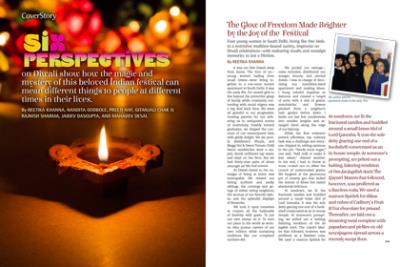
Six essays on Diwali show how the magic and mystery of this beloved Indian festival can mean different things to people at different times in their lives.
By REETIKA KHANNA, NANDITA GODBOLE, PREETI HAY, GITANJALI CHAK & RAJNISH SHARMA, JAIDEV DASGUPTA, AND MAHADEV DESAI.
The Glow of Freedom Made Brighter by the Joy of the Festival
Four young women in South Delhi, living like free birds in a restrictive tradition-bound society, improvise on Diwali celebrations—with endearing results and nostalgic memories to last a lifetime.
By REETIKA KHANNA
It was our first Diwali away from home. The four of us— young women hailing from small towns—were living together in a one-room terrace apartment in South Delhi. It was the early 90s. For unwed girls to live beyond the protective grasp of family while constantly contending with social stigma was a big deal back then. We were all grateful to our progressive, trusting parents for not tethering us to antiquated norms of conformity. Freshly minted graduates, we shaped the contours of our emancipated lives with giddy delight. We ate poorly (Haldiram’s Bhujia, and Maggi Hot & Sweet Tomato Chilli Sauce sandwiches were a staple), drank unfiltered tap water, and slept on the floor. But we had thirty-nine pairs of shoes amongst us! We had arrived.
As Diwali closed in, the nostalgia of being at home was inescapable. We missed our doting mothers and pesky siblings, the comings and goings of mithai toting neighbors, the aromas of our favorite dishes, and the splendid displays of fireworks.
We took it upon ourselves to conjure all the hallmarks of festivity with gusto. To put our own stamp on it. To earn our place in the world as women who pursue careers of our own volition while sustaining traditions like our compliant mothers did.
We pooled our savings— coins included, distributed our meager bounty, and elected duties. I was in-charge of decorating our matchbox-sized apartment and making kheer. I hung colorful dupattas as festoons and created a rangoli of sorts with a mix of grains, matchsticks, and flowers plucked from a neighbor’s lush garden before dawn. I broke our last few candlesticks into smaller lengths and arranged them along the edge of our balcony.
[Right] The author and her
apartment mates in the early ‘90s.
While the first endeavor proved effortless, my culinary task was a challenge and everyone chipped in, adding opinions to the pot. “Needs more sugar,” one said. “Add milk to make it less sweet,” chimed another. In the end, I had to throw in more cooked rice to offset the crunch of undercooked grains. We laughed at the ginormous pot of creamy goo that lacked the stature of kheer but tasted absolutely delicious.
At sundown, we lit the fractured candles and huddled around a small brass idol of Lord Ganesha. It was the sole deity gracing one end of a bookshelf consecrated as an in-house temple. At someone’s prompting, we pelted out a halting, faltering rendition of Om Jai Jagdish Aarti. The Gayatri Mantra that followed, however, was proffered as a flawless coda. We used a maroon lipstick for tikkas and cubes of Cadbury’s Fruit & Nut chocolate for prasad. Thereafter, we laid out a steaming meal complete with papadam and pickles on old newspapers spread across a recently swept floor. We had neither rupees nor room enough for a dining table. Besides, heels were always higher up in the hierarchy of needs.
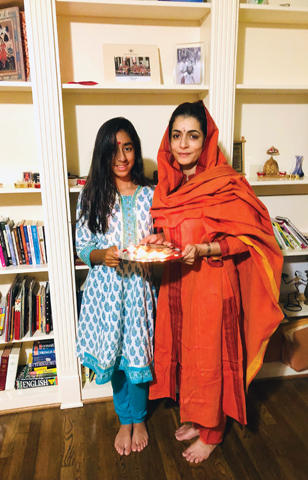
[Right] The author and her daughter during Diwali 2019.
Our modest stash of fireworks went up in smoke in a flash. Undeterred by our insufficient funding, we resorted to making a bonfire out of two broken doors our unscrupulous landlord had dumped on our terrace. He had promised to have the junk removed months ago. The wood caught fire quickly. Great leaping flames danced in glorious retribution. They warmed our cold hands and winter flushed faces as we sang Hindi film songs horribly off-key. Our unabashed laughter rose like flares in the speckled night.
Decades later, the four of us have spread across continents as homemakers and rule-breakers. Every Diwali we reminisce about our first Diwali together. And we remind ourselves that freedom and love fuel lasting happiness.
[Reetika Khanna Nijhawan is an Atlanta based freelance writer, and author of Kismetwali & Other Stories. She writes to shine the light on the human spirit as articulated through creative, iconoclastic expression.]
Joy in a Box
The magic allure of mithai multiplied tenfold during this most joyful time of the year.
By NANDITA GODBOLE
As a child growing up in Mumbai, India, I knew one thing that united friends of all denominations—the Diwali celebrations. It brightened doorsteps and neighborhoods, brought smiles, and lit everyone’s hearts with joy.
In preparation for Diwali, our apartment would get a thorough cleaning, and then, my mother would rearrange our furniture for maximum seating. Diwali was a time for lots of visitors as family, friends, and even my father’s colleagues would stop by to offer Diwali wishes. Some came to seek blessings from my parents as their elders, but this was more than just visiting.
With them came mithai boxes, a customary gifting staple during Diwali. Representing smaller sweet shops, or halwai, these colorful boxes tempted us with decadent regional flavors. Unlike any other festival, every halwai competed for attention at Diwali. Many sizes of zari clad cardboard boxes arrived, whose insides were often lined thinly with a very delicate sheet of parchment paper. Within their folds were precariously placed perishable morsels of brightly colored confections. Sugar, white flour, ghee, milk, and nuts assembled in fudgy, crumbly, or spongy shapes; fragrant and aromatic, oozing sugar syrup, their delicate flavors lingering on our tongues, soaking our spirit with both warmth and sweetness.
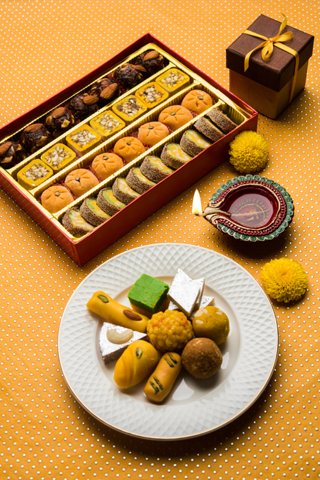
Middle-class homemakers were seldom afforded the luxury of purchasing mithai to ease their kitchen responsibilities. But even if they purchased mithai versus making it, there was a fair amount of hassle involved! In our home, everyone had their favorite stores and favorite treats from behind the glass cases. The best hot jalebi and ganthiya came from a crowded store near my grandmother’s old home, crumbly boondi laddoo from another, while airy sutterfeni and pedha only came from D. Damodar Mithaiwala in the heart of our favorite shopping area.
Mithai shopping meant that one would have to wait for hours in a crowded store, shout over the glass case to the attendant, tell them specific combinations of mithai per box, jostle through the crowds to reach the cashier, pay, and then walk out with delicious and tempting confections in boxes! We had our fair share of samplings from elsewhere too: a family friend with ties to Surat would bring us ghee-laden ghari, and Muslim friends stopped by to sample my mother’s treats with halwa from their own eighborhoods. Meanwhile, my father’s dear friend, a cloth merchant, would bring us the choicest delicate Bengali mithai from the heart of the traders’ markets in Mumbai along with boxes of the best saffron for my mother’s desserts.
[Top] Boxes of Joy
Those Diwali days seem so far away in time, chaotic yet so much simpler, so busy but so much more joyful!
At my very first Diwali in the US, I wished an Indian classmate, “Happy Diwali.” He was startled at the greeting, as he had lived away from India for some years already. To him and many other international students like me, Diwali had become one more part of our culture that was boxed away, because it did not fit with an American life. That same weekend, I attended an “India-nite” dinner organized by the Indian students’ association on campus. It seemed obligatory to observe a celebration with strangers. It felt soulless: we were all brown; but for an introvert like me, it was just another crowded gathering.
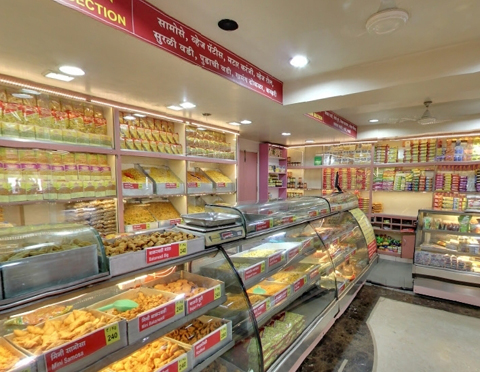
Those moments were almost a foreshadowing of Diwali days that followed. For a few years after, I did not celebrate Diwali as I always missed my ‘back home.’ When I married, we began attending Diwali potlucks, or joining a few other families over dinner. It felt like a strange kind of speed dating, but for families. If the year went on and we did not see those folks again because we had been just too busy, it meant we had to start over again.
Living away from India has chipped away at so many of our culturally unique traditions, including these seemingly silly mithai box exchanges at Diwali. They were an excuse to make time to make visits to the homes of elders and loved ones. They were joyous pretenses to visit dear ones, to sample treats unashamedly from large platters, or to sip several small cups of chai in the company of visitors. We took time to laugh together sharing in the joy of relationships.
But somewhere during the layovers between our cultural ‘back-homes’ and our adopted homes, we seem to have lost the nuances of our rich cultural celebrations, in favor of efficiency, convenience, and distance.
If there is an unseen benefit in this most unusual year, it is that we have been given time to recognize these nuances of our cultural celebrations, and an opportunity to observe them in the way they were meant to be celebrated: in building and strengthening relationships, beginning first at home. And although we cannot gather together in person, I will be making some Diwali sweets to share, and even sending over mithai boxes by mail, reclaiming my celebrations again, one mithai-filled, joy-filled box at a time.
[Nandita Godbole is an Atlanta-based author and food writer. Her biographical fiction, Ten Thousand Tongues: Secrets of a Layered Kitchen was featured on City Lights–WABE (Atlanta’s NPR), Forbes, and BBC-Future, and in an earlier avatar, on NBC and NBC-Asian America.]
The Solitude in Diwali
Family, feasting, dancing, and diyas. Hidden behind the glitzy, external trappings of Diwali lies its deeper significance— the triumph of the human spirit— one that can be celebrated as joyously in solitude as in a crowd.
By PREETI HAY
Have you ever wondered how isolated families or individuals celebrate Diwali? The Festival of Lights is always associated with large family gatherings, the pomp and elation of the extended clan coming together, fireworks, feasts, and gambling. But what of those that do not have these external connections or means? What does Diwali mean to them? Or for those who feel alone, despite all the outer trappings?
After my mother died when I was a teenager, Diwali assumed a reversed role for me. Its light did not dispel darkness but caused more darkness. Large family gatherings came to an abrupt, jerky halt. It was just my father and me. Neither of us knew how to do Lakshmi Pooja and there was no one to explain the significance of these rituals, which became insipid. Slowly, we dropped them altogether. The fireworks lost their charm as the air got more polluted and we had to rewrite our rules for Diwali.
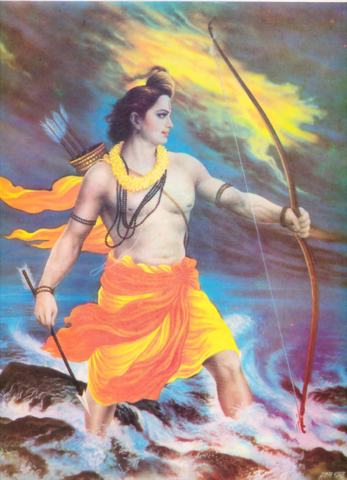
Over the years, we came up with fun things to do. We watched movies and took vacations. My best friend and I included my dad in our adventures of late-night café hopping and enjoyed seaside walks on deserted Mumbai streets on Diwali night—what a treat!
But the gift of the external change was, and still is, the questioning of the real meaning of Diwali. As the external layers dropped off, deeper significances were revealed.
[Left] Lord Rama
Diwali makes me think deeper about solitude. In my going within to explore its significance, I formed a kinship with Lord Ram. I saw him as a classical hero with inner and outer conflicts and a true hamartia—a fatal flaw— that of undying obedience to
his father.
Ram’s exile was but an outer symbol of solitude. Fourteen years out of the palace, a period that transformed a prince with a bright future into a surviving wanderer. It was a solitude that bred in the young prince, the strength of forbearance, fortitude, devotion, and transformation.
The light that emerges out of darkness which signifies Diwali is not only the diyas lit on the Amavasya night of Ram’s return from exile, but the endless opportunities for transformation with which life presents us. And stepping out of this darkness into the light is the stuff that heroes are made of.
In fact, the Ramayana is full of stories of solitude, and thus stories of choices. Sita’s choice when left alone within the lakshman rekha, Lakshman’s choice to follow his brother into lonely exile, Ahalya’s patience in awaiting Lord Ram’s touch to free her from the stone form, and even Ravana’s endless penance in solitude, to achieve his matchless powers.
No, not all choices are pleasant, and no hero is unflawed. Sita’s choice, to leave the protection of the lakshman rekha, led only to more solitude as Ravana’s captive in Lanka, where she pined for Ram every minute. Her devotion brought her no rewards; rather, Ram expelled Sita from his kingdom, choosing to bow down to public rumors about her virtue. Such was the complexity and imperfection of their lives. And that’s how our lives are, and will be, until the end of human existence.
Whether you are surrounded by festive crowds or feel culturally isolated, far from your homeland, it’s worth remembering this—that Diwali is not an external action, it is a statement. One that can be whispered within, in the depth of our hearts, where we fight battles each day to correct our own wrongs, and take inner steps to dispel our own darkness.
[Preeti Hay is a freelance writer published in The Times of India, Yoga International, Khabar magazine, India Currents and anthologies of fiction and poetry.]
Celebrations Across Continents
The spirit of the festival burns bright and happy bringing goodwill, warmth, and smiles wherever it is celebrated.
BY MAHADEV DESAI
As a schoolboy in Nairobi, Kenya, the festival that I most looked forward to was Diwali. It was not a public holiday, but Indians parents took time off from work and children stayed away from schools. The age-old Indian traditions of Diwali continued seamlessly in our Kenyan lives. I listened, fascinated, to my mother’s stories about the religious significance of Diwali; of Rama and Sita, and their triumphant return to Ayodhya after fourteen years in exile. My mother made traditional snacks—ghooghra, magaj, nankhatai, chakri, mathiya, chevdo, and more. She decorated the entrance to our home with traditional colors of rangoli and placed diyas, the earthen lamps, in front of garlanded deities as well as all along the windowsills.
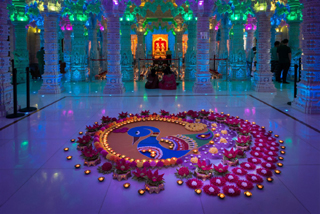
Our circle of friends and family grew bigger after my brothers and I got married. My sisters-in-law and my wife teamed up with my mother on the Diwali preparations. Once we acquired a car, we drove to downtown Nairobi to enjoy the festive Diwali illuminations in the Indian shops which lent them a magical touch. Some of our neighbors from Patel, Lohana, and Shah communities celebrated Diwali in their community halls or clubs with live entertainment or card-parties.
Diwali adornments at the BAPS-Atlanta temple in Lilburn, Georgia.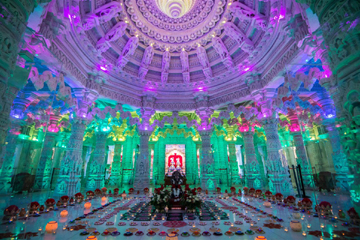
Much later, in 1974, my wife and I left Kenya with our teenage daughter for London. We lived in a mostly white neighborhood with just a few Hindu neighbors, but soon we succeeded in celebrating Diwali much like we used to in Nairobi. We made new friends and office colleagues; and also found a few families from Nairobi. We also attended spectacular Diwali festivals at the BAPS Mandir in Neasden, London. Some areas with a significant Indian presence—like Southhall and Wembley—put up glittering lights, lanterns, and decorations; blasted music and played live drums; set off firecrackers, and exchanged Diwali greetings with the enthusiastic and cheery public.
Some years later, my daughter got married and moved to Atlanta. My wife and I joined her and my son-in-law in September, 1990. We now celebrate Diwali with her, my son-in-law, and granddaughter observing the same traditions we followed in Nairobi and London.
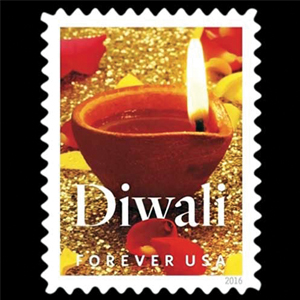
As a journalist, I am fortunate to be invited for several public Diwali celebrations. I have fond memories of two such grand celebrations. One is the 2011 event hosted by Gujarati Samaj of Atlanta. Over 1000 invitees participated in the joyous annual Diwali dinner at the beautifully decorated Sardar Patel Bhavan Hall.
The other memorable event, in 2015, was the BAPS Swaminarayan Sanstha’s first Diwali celebration at the GA State Capitol under the vision and inspiration of H.H. Pramukh Swami Maharaj.
Every year since, the BAPS Mandir in Atlanta organizes a five-day Diwali celebration replete with color and festivity that’s attended by thousands of Atlantans. They put out an eye-catching array of imaginatively designed floats and displays of annakut, a medley of vegetables cooked together. The food court offers freshly cooked, tasty food, and drinks. On sale are Diwali snacks, sweets, herbal health products, and gift items.
Inevitably perhaps, traditional ways of celebrating Diwali have changed. Cold weather and long distances now make it difficult to visit homes; many settle for a temple visit or community get-together. Traditional homemade mithais, the Indian sweets, have given way to store bought ones or online deliveries. On the plus side, Diwali is now more inclusive, with people of other faiths being invited to join in the festivities.
Happily for Indians in the U.S., Diwali has reached the White House, having been celebrated by Presidents Bush, Clinton, Obama, and now Trump. It is also commendable that the US Postal Service issued commemorative Diwali stamps in October 2016. This was followed, in November 2018, by the United Nations issuing a commemorative set of Diwali stamps.
Diwali, the festival of lights, is the biggest and brightest of Hindu festivals. It celebrates the victory of good over evil, knowledge over ignorance, and light over darkness. Let’s preserve its cultural and spiritual significance amidst the fun and celebrations.
[Mahadev Desai has been a prolific reporter for the Indian community in Atlanta, and an avid writer.]
Family Traditions Across India
BY GITANJALI CHAK & RAJNISH SHARMA
As soon as there’s a nip in the air in October, you know that the festival that never loses its sparkle, is on its way to fill up your senses and imbue everything around you with vibrancy and a sense of well-being. Not to forget the feeling of nostalgia that Diwali brings along with it—a longing for the times gone by!
Rajnish and I grew up in two different parts of the country. We also grew up in different family structures—he in a joint family, and I in a nuclear one. Even so, while we have our own respective experiences to share, we also share some similar traditions.
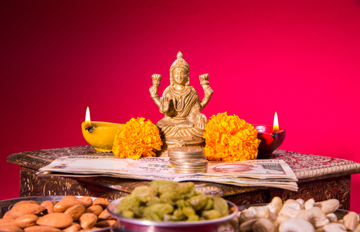 [Top] Lakshmi Pooja, a popular and auspicious Diwali tradition across many regional cultures in India.
[Top] Lakshmi Pooja, a popular and auspicious Diwali tradition across many regional cultures in India.
For Rajnish, as also for me, the utsav started with Dhanteras two days prior to Diwali. Marked as a day that brings one dhan (good fortune and wealth), this is when ladies of the house would visit the teeming city markets to buy new steel or brass utensils besides silver and gold coins. This tradition endures to this day. This was followed by Chhoti Diwali when yama diya, a small lighted lamp in honor of Lord Yama, was placed outside the house gate. We follow this even
now in our home.
Rajnish has vivid memories of Diwali mornings when his mother made imprints of Lakshmi Ji’s padchinh, the footprints, right from the main door to inside the house using a slurry rice mixture. The belief is that Lakshmi Ji, the Goddess of Wealth, visits one’s house at night and looking at all the cleanliness, blesses you with wealth and prosperity. We no longer make the rice flour footprints.
Come Diwali evening, the entire family of Rajnish would gather for the Lakshmi-Ganesh pooja with each member doing aarti while singing bhajans. Soon after, ghee diyas placed all around the house, were lighted giving the home a divine look, says Rajnish. The children rushed to burst crackers on the terrace or the front lawns. The pitch dark Amavasya, the no moon night sky, would serve as a backdrop for our spirited celebrations.
Dinner was a sumptuous spread of lip-smacking traditional dishes like poori-kachauri, mithai (laddoos were a must), chhene-paneer ki sabzi, and of course, dahi-bada just had to be there! Alas, I have to admit that the Diwali dinner in our home is not as lavish now and I think it has to do with the fact that we don’t have the staff that both Rajnish and I were privileged to have earlier as children.
My enduring memory of Diwali in my childhood is the pooja that was presided over by our family guruji in the evening. My sister and I, dressed in our new Diwali outfits, didn’t understand a word of what the genial old man was uttering. It seemed gibberish to us, but we bore it patiently for the simple reason that it was only after the pooja that we were allowed to gorge on the delicious Diwali sweets, beautifully arranged on the thaali with a glowing diya in the center!
Sadly, guruji passed away and my mother took to doing the pooja; and now that she is no more too, the mantle has fallen on me. It’s a simple affair, still pretty, but much less preparation goes into it. A sign of the changing times, I guess!
But this is one tradition that I would love my daughter to carry on, which I think she will. With her keen aesthetic eye, she painstakingly helps me put together the various items for the pooja—among them cheeni ke khilone, the sugar toys mostly in animal shapes—and has also started diligently reciting the Laxmi Chalisa along with Rajnish and me.
The one thing that both Rajnish and I miss on Diwali are the fun-filled family get-togethers that we enjoyed as children. People around us just seem to have vanished! But Diwali means fireworks, right? So, let the party begin—even if it is just the immediate family!
[Gitanjali Chak and Rajnish Sharma are journalists based in Lucknow, India. They also host Khabar’s Bollywood column.]
The Spirit of Togetherness
BY JAIDEV DASGUPTA
For a Bengali growing up in Uttar Pradesh, Diwali was an add-on; a bonus festival if you will. Durga Pooja is major festival of Bengalis, which after five days of celebration, culminates in Vijaya Dashmi, commonly known as Dussehra. Five days after Vijaya Dashmi, they celebrate Lakshmi Pooja, also known as Bengali Lakshmi Pooja, also known as Kojagari Poornima. And then comes the preparation, anticipation, and excitement of Diwali. Filled with festivals one after another, it is a month of celebrations.
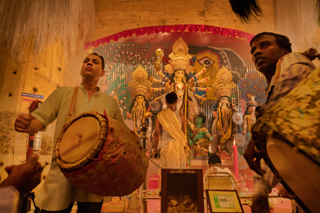 [Top] Durga Pooja celebrations in Kolkata.
[Top] Durga Pooja celebrations in Kolkata.
Lakshmi, the Goddess of Prosperity, is worshipped by many on Diwali night. As a child, I used to sometimes wonder why the same deity was worshipped twice over a two-week period by different communities, and why Bengalis worshiped Kali on Diwali night, and not Lakshmi like others. But I never bothered anyone with my questions. As a child, more festivals meant more fun time with friends, mouthwatering food and sweets, new clothes, and fire crackers. And on top of that, less pressure of homework from school! Both teachers and parents went easy on us in the festival month.
At the start of autumn, the atmosphere everywhere appeared charged. Post monsoon, the city turned bright and new with freshly white-washed homes and clean roads. The heightened excitement in busy marketplaces, shops decorated with lights and loaded with goods, days still warm but the evenings and nights cooling off: all heralded the arrival of autumn and welcomed Diwali. Grace and goodwill seemed to fill the air. Homes and temples shimmering with little lamps elevated the spirit.
So deeply embedded within me was the association of autumn with the festive season, that for more than ten years after coming to the U.S., the arrival of fall would arouse a sense of anticipation and an inexplicable uplifting of the spirit. But in the absence of a corresponding charge and excitement in society to mirror and reinforce that sense within me, the feeling gradually faded. And this may be the case with many in the diaspora community. Despite the many temples and Indian community societies that celebrate Durga Pooja and Diwali, the effect is not the same; the mood is not as exalted. These special days come and go almost in a matter-of-fact manner, bereft of anticipation and inner radiance.
This waning of spirit could be attributed to age, a busy lifestyle or too much of materialism; but the fact remains that a social being’s individual happiness depends on the happiness of the surrounding community.
One imbibes energy and excitement from the local ethos and, in turn, gives it back. In doing so, one transcends the limited boundaries of individuality and becomes part of a larger whole— which is where, I believe, lies the source of grace and goodness, and of sacredness in life. Herein lies the importance, the essence of Diwali.
With greater awareness and increasing celebration of this festival throughout the world, one can hope that the event will foster the spirit of togetherness which is much needed for joyous and harmonious co-existence. May keeping alive the ritual of the Festival of Lights enlighten souls, brighten lives, and knit the world into a family.
[Jaidev Dasgupta is the author of In Search of Immortality: An Introduction to Indic World-Views (New Delhi, India: Manohar, 2015). He writes on topics in Indian education, culture, and philosophy. He is a scientist (M.S. in Physics, Ph.D. in Biology), technologist, and entrepreneur.]
Enjoyed reading Khabar magazine? Subscribe to Khabar and get a full digital copy of this Indian-American community magazine.
blog comments powered by Disqus











